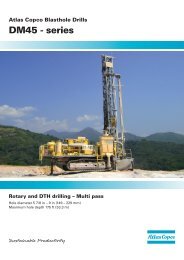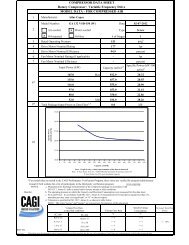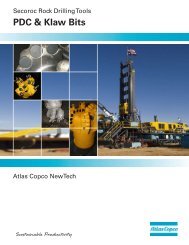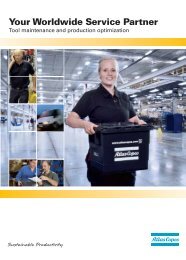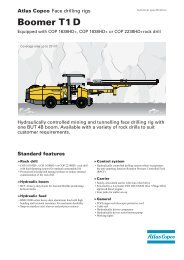Download - Atlas Copco UK
Download - Atlas Copco UK
Download - Atlas Copco UK
Create successful ePaper yourself
Turn your PDF publications into a flip-book with our unique Google optimized e-Paper software.
Superior energy-efficiency<br />
A dryer’s energy consumption mainly goes to internal pressure drops and the regeneration process. The key for designing<br />
desiccant dryers is therefore to keep the pressure drop as low as possible, and to develop technologies that allow<br />
regeneration to be as efficient as possible. <strong>Atlas</strong> <strong>Copco</strong>'s dryers are designed to have a very low internal pressure drop<br />
below 0.2 bar/2.9 psi, and provide the most efficient regeneration process.<br />
Low pressure drop saves energy<br />
and reduces operating costs<br />
If a desiccant dryer experiences a high internal pressure drop, the<br />
compressor discharge pressure must be set higher than required,<br />
which wastes energy and increases operating costs. <strong>Atlas</strong> <strong>Copco</strong><br />
has therefore put considerable efforts into minimizing pressure<br />
drops in its dryers. The result is that most CD + , BD + and XD +<br />
desiccant dryers have a pressure drop below 0.2 bar/2.9 psi.<br />
Annual<br />
energy<br />
cost<br />
0<br />
1 bar/14.5 psi<br />
Pressure drop<br />
Efficient regeneration due to Dewpoint<br />
Dependent Switching<br />
<strong>Atlas</strong> <strong>Copco</strong>’s CD + , BD + and XD + desiccant<br />
dryers incorporate state-of-the-art energy<br />
management control with built-in Dewpoint<br />
Dependent Switching. This makes the<br />
dryers more efficient, leading to energy<br />
savings of up to 90%, depending on<br />
installation and usage.<br />
The principle is simple. Although the regeneration time remains<br />
constant, the delay before switching from one tower to the other is<br />
controlled via the PDP sensor. This is connected to a hygrometer<br />
which precisely measures the remaining humidity in the outlet<br />
compressed air. As soon as the target PDP is reached, the dryer cycle<br />
that was on hold will resume by switching to the dry tower.<br />
Delaying cycles in this way leads to major energy savings. This occurs<br />
when operating conditions are lower than reference, or the flow<br />
fluctuates below maximum nominal load.<br />
Typical dryer<br />
<strong>Atlas</strong> <strong>Copco</strong> dryer<br />
Pressure drop (on average 10%)<br />
Regeneration (on average 90%)<br />
Reduced pressure drop below 0.2 bar/2.9 psi<br />
Dewpoint Dependent Switching for energy savings up to 90%




